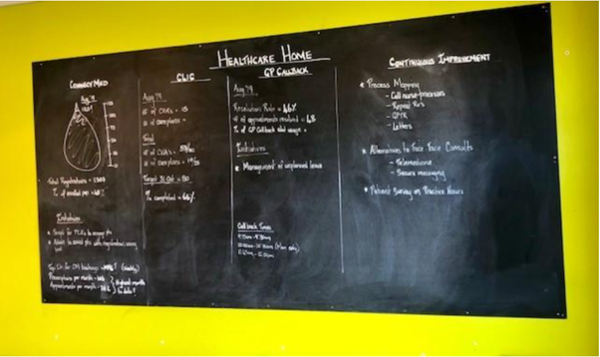
Visual Board
Learning Objective: To understand the purpose of a visual board, the information that should be displayed and the benefits to the practice of displaying this information.
What is a visual board?
A visual board is a tool used to pass on key information quickly and efficiently, letting staff know the aims and targets of the practice. Information represented visually is not only understood quicker, it is retained more effectively too.
Why implement a visual board?
The visual board empowers the team to achieve practice goals by encouraging targeted conversations and increased collaboration, using the data displayed on the board as a motivator. The benefits of visual boards include increased success at achieving practice goals due to more accountability and an empowered workforce which knows the direction and goals of the practice, therefore meaning everyone can work towards these goals.
Who does what?
|
Staff |
Role |
|
Receptionists/Administrators |
Actively engage in discussion and work to achieving the targets outlined on the board. |
|
Nurses |
Actively engage in discussion and work to achieving the targets outlined on the board. |
|
General Practitioners |
Actively engage in discussion and work to achieving the targets outlined on the board. |
|
Board Champion / Huddle Champion |
Update the board frequently with valuable information (see below for ideas). Use the board to generate discussion or celebrate successes (link with huddles). |
|
Management |
Provide physical space for board. Delegate a board champion (usually the same person who manages the huddles). Support the board champion by informing them of practice priorities and goals. |
|
WellSouth |
Assist the practice in deciding what information should be displayed on the board. Show how Thalamus can be a useful tool to gather information to display. Assist with putting up the visual board and help create a process for the data to be updated regularly. |
What do you put on a Visual Board
Each practice should decide what goals/targets are important to them and align their visual board to help in achieving these goals. The board needs to work for your practice.
However, some ideas to get you started include:
- People – roles and responsibilities, rosters, training & skills, room allocation.
- Performance – key performance indicators and tracking targets across current projects.
- Continuous Improvement – project ideas, problem solving, action plans.
For an example visual board see below.
Implementation timeline
Preparation:
- Appoint a board champion (generally the same person as the huddle champion).
- Find an appropriate space for the board. Remember there must be room for people to huddle around it.
- Source a board that best works for your practice.
- Decide what you will put on the board.
- Engage staff.
Month 1:
- The board should be ready for the first huddle.
- Refine what is displayed on the board.
- Survey staff (tie in with Huddle survey at end of month 1).
Month 2
- Analyse staff feedback and implement any changes if necessary.
- Use of the board becomes embedded into the General Practice daily routine.
How to measure success
One quantifiable measure of success is to keep track of how frequently the data is updated. When surveying staff on huddles it would be good to include a question on how useful the board and data it displays are.
Other less quantifiable measures of success would be staff involvement in providing information and interest in viewing the data displayed. Staff would also be enthusiastic and engaged planning and implementing continuous improvement projects.
Helpful Tips
Effort is required to keep the board going and relevant.
The board should not sit in an office where no one sees it.
If it is hard to find space – work it whatever way works for your practice.
Don’t need a fancy board - can use an old-fashioned blackboard and chalk. (see picture below)
Include on each piece of data when it was last updated, this will let staff know what they are looking at is relevant and makes the board champion more accountable for updating the board.